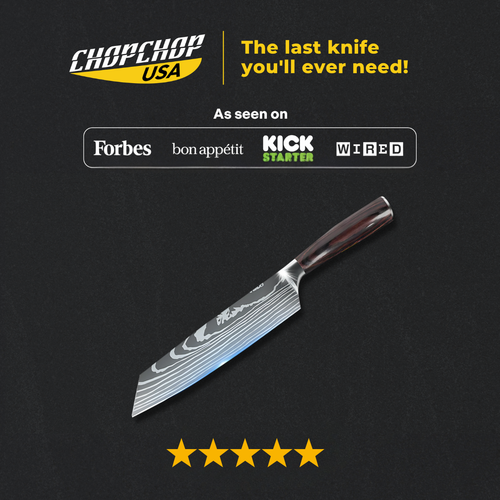How Much Does a Frying Pan Weigh? What is the Ideal Frying Pan Weight? Frying pan weight varies depending on material, size, and construction, with most pans ranging from 1–4 pounds (0.45–1.8 kg). The ideal weight strikes a balance between heat retention and ease of handling.
In this guide, ChopChop USA will walk you through why frying pan weight matters, key factors influencing it, typical weight ranges for common pan types, how it affects cooking, and tips to choose the right weight for your kitchen.
Why Should I Care About Frying Pan Weight?

Cooking Control and Maneuverability
The weight of a frying pan directly impacts how easily you can maneuver it. Lightweight pans are easier to lift, toss, and handle, making them ideal for everyday cooking, sautéing, or flipping delicate foods like eggs or fish. Considering how much does a frying pan weigh ensures you can handle it safely and efficiently.
Heat Retention and Performance
Heavier pans, such as cast iron or thick stainless steel, retain heat better and provide more consistent cooking. They’re perfect for searing meat, browning vegetables, or maintaining stable temperatures for slow-cooked dishes. Knowing how much does a frying pan weigh helps you choose one that balances heat retention with comfort.
Comfort and Safety
A pan that’s too heavy can strain your wrists and arms, especially when full of food. Considering weight helps prevent fatigue and reduces the risk of accidents. Understanding how much does a frying pan weigh is essential for comfort and safety in the kitchen.
Understanding pan weight helps you select cookware that enhances cooking performance while keeping handling comfortable and safe. This is why frying pan weight is an essential factor when building your kitchen collection.
5 Key Factors Influencing Frying Pan Weight

Several factors determine the weight of a frying pan, affecting how it performs and feels during cooking. Understanding these key elements helps you choose a pan that balances heat retention, durability, and ease of use, and answers the question: how much does a frying pan weigh.
Material
Different materials weigh differently. Cast iron is extremely heavy, ideal for heat retention, while titanium and carbon steel are lightweight yet durable. Stainless steel and ceramic fall in between, depending on thickness and layers. Knowing how much does a frying pan weigh depends on its material.
Size / Diameter
The larger the pan, the heavier it generally is. A 12-inch pan will weigh significantly more than an 8-inch pan, and this increases further with thicker materials. Considering how much does a frying pan weigh is important when selecting the right size for your kitchen.
Construction / Layers
Multi-layered pans with aluminum or copper cores distribute heat evenly but add weight. Nonstick pans are often thinner, making them lighter. Understanding how much does a frying pan weigh requires noting its construction.
Handle and Lid
Ergonomic handles, heavy lids, or rivets can add to the total weight. Longer handles or lids made from stainless steel or cast iron can increase strain during cooking. Always check how much does a frying pan weigh including handle and lid.
Intended Use
Professional chefs may prefer heavier pans for heat control, while home cooks may prioritize lightweight pans for ease of use. Weight must match your cooking style to avoid fatigue and ensure safety. Considering how much does a frying pan weigh helps you make the right choice.
Typical Weight Ranges for Common Frying Pan Types
Frying pans come in a variety of materials and sizes, each with a characteristic weight range. Knowing how much does a frying pan weigh for common types helps you select the right one for your cooking style and comfort.
Ceramic Frying Pan
The ChopChop USA Ceramic Frying Pan has the following sizes and weights:
- 9.45" (24 cm) – 1.76 lbs (800 g)
- 11.02" (28 cm) – 2.03 lbs (920 g)
- 11.81" (30 cm) – 2.2 lbs (1000 g)
Cast Iron Skillet
The ChopChop USA Cast Iron Skillet has the following sizes and weights:
- 3.9" (10 cm) – 0.7 lbs (320 g)
- 5.5" (14 cm) – 1.12 lbs (510 g)
- 6.3" (16 cm) – 1.43 lbs (650 g)
- 7.9" (20 cm) – 2.51 lbs (1140 g)
- 10.2" (26 cm) – 4.3 lbs (1950 g)
Carbon Steel Pan
The ChopChop USA Stainless Steel Frying Pan has the following sizes and weights:
- 9.5" (24 cm) – 700 g (~1.54 lbs)
- 10.2" (26 cm) – 900 g (~1.98 lbs)
- 11" (28 cm) – 1200 g (~2.65 lbs)
Stainless Steel Frying Pan
The ChopChop USA Stainless Steel Frying Pan has the following sizes and weights:
- 9.45" (24 cm) – 1.82 lbs (825 g)
- 10.24" (26 cm) – 2.16 lbs (980 g)
- 11.02" (28 cm) – 2.47 lbs (1120 g)
- 11.81" (30 cm) – 2.84 lbs (1290 g)
How Weight Affects Your Cooking Experience
Frying pan weight directly impacts control, heat retention, and overall cooking comfort. Choosing the right weight ensures better performance and a safer, more enjoyable experience in the kitchen, highlighting why how much does a frying pan weigh matters.
Control and Maneuverability
Heavier pans require more effort to lift and move, while lighter pans are easier to handle, ideal for flipping or sautéing delicate foods. Considering how much does a frying pan weigh ensures proper control.
Heat Retention and Distribution
Heavy pans like cast iron or thick stainless steel retain heat longer and cook more evenly. Lightweight pans heat faster but may lose temperature quickly. Knowing how much does a frying pan weigh helps balance heat performance with ease of use.
Cooking Style Compatibility
- Heavy pans: Great for searing, braising, and slow-cooking.
- Light pans: Perfect for quick sautéing and eggs.
Safety and Comfort
The right-weight pan reduces fatigue, prevents spills, and makes handling safer. Understanding how much does a frying pan weigh helps maintain safety.
Overall Experience
Balanced weight enhances cooking efficiency, precision, and enjoyment, making meal preparation smoother and more satisfying.
How to Choose the Right Weight for Your Needs

Choosing the right frying pan weight ensures comfortable, safe, and efficient cooking. Understanding how much does a frying pan weigh helps you select a pan that balances heat performance and ease of use.
Assess Your Cooking Style
Frequent sautéing or flipping? A lighter pan is easier to handle. For slow-cooked dishes, heavier pans like cast iron or thick stainless steel are ideal. Knowing how much does a frying pan weigh helps match your pan to your cooking style.
Consider Your Strength and Comfort
Heavier pans can strain wrists and arms, especially when full. Choosing the right weight improves comfort and safety. Checking how much does a frying pan weigh ensures you avoid fatigue.
Material Matters
- Titanium and carbon steel: Lightweight yet durable.
- Cast iron: Heavy, excellent for heat retention.
-
Stainless steel or ceramic: Moderate weight.
Understanding how much does a frying pan weigh by material helps select the right pan.
Pan Size
Larger pans weigh more. Matching size and weight ensures you can lift and maneuver safely. Knowing how much does a frying pan weigh for each size helps you choose the perfect fit.
Multi-Layer vs. Single-Layer Construction
Multi-layer pans improve heat distribution but add weight. Single-layer pans are lighter but heat less evenly. Considering how much does a frying pan weigh helps you balance performance and handling.
5 Tips for Handling Heavy Pans
Using heavy frying pans can be challenging, but proper handling makes cooking safer and more comfortable. Knowing how much does a frying pan weigh helps you handle them safely.
- Use both hands when lifting large or full pans.
- Wear oven mitts or heat-resistant gloves for better grip.
- Avoid overfilling pans to reduce weight strain.
- Use pan rests or trivet when moving heavy pans from stovetop to table.
- Store heavy pans at lower shelves to prevent accidents and make handling easier.
Ready To Shop?
Equip your kitchen with the ChopChop USA Cookware Collection, crafted for performance, durability, and everyday cooking excellence.
- Titanium Pan Pro: Ultra-lightweight, corrosion-resistant, and perfect for precise cooking.
- Stainless Steel Frying Pan: Multi-layered for even heating, ideal for searing and browning.
- Hybrid Nonstick Frying Pan: Stainless steel with microcraving technology for effortless cooking and easy cleanup.
- Ceramic Frying Pan: Naturally nonstick and toxin-free, perfect for healthy cooking.
- Cast Iron Skillet: Superior heat retention and naturally nonstick with seasoning.
- Carbon Steel Pan: Lightweight yet responsive, perfect for stir-frying and high-heat cooking.
ChopChop USA cookware balances durability, style, and functionality, ensuring your cooking experience is effortless, safe, and professional.
Conclusion
Choosing the right frying pan weight affects control, heat retention, and overall cooking experience. From lightweight titanium and carbon steel pans to heavier cast iron or stainless steel, matching pan weight to your needs ensures comfort, efficiency, and optimal results.
Explore the ChopChop USA Cookware Collection for durable, versatile, and stylish pans that make every meal better. Understanding how much does a frying pan weigh is key to a perfect cooking experience.
For more amazing recipes, follow me on Facebook and Instagram! If you have any questions about ChopChop USA's products or promotions, please feel free to contact us at support@chopchopusa.com. Our dedicated team is available 24/7 and always happy to assist you.
Frequently Asked Questions
1. What is the ideal weight for a frying pan?
Most pans range from 1–4 lbs (0.45–1.8 kg); ideal weight balances heat retention and ease of handling.
2. Are heavier pans better for cooking?
Heavier pans retain heat and cook evenly, but may be harder to maneuver. Choose based on cooking style and comfort.
3. How does pan size affect weight?
Larger diameter pans weigh more. A 12-inch pan is heavier than an 8-inch pan, regardless of material.
4. Can I use heavy pans on induction cooktops?
Yes. Cast iron, stainless steel, and carbon steel pans work on induction, but weight may affect handling.
5. How can I safely handle a heavy frying pan?
Use both hands, oven mitts, and avoid overfilling. Store pans at lower shelves for safety and convenience.




